Sid Meier's Alpha Centauri - Micro Map Speed Transcendence
This is a followup to my old original speed transcendence run from ten years ago. My aim is to reprise and improve both the gameplay and writing from that, with everything I learned throughout the sequence of games listed on the home menu here.
The parameters common to both the old run and this:
- University of Planet faction, nothing else comes close for speed-running of course
- Transcend difficulty, because I want to
- Settings for the micro map runs, that differ from my standard set on the other writeups here:
- Smallest map size the game allows at 16×16, for the lowest tech costs
- Strong erosion rather than average, for less rockiness and elevation trouble with boreholes
- Rare native life
- Dense cloud cover (more rainy)
- Pod scattering on
- Unity Survey on
And strategically, this is what I intend to do differently this time than in that old micro-map game:
- Build the Planetary Transit System to grow and expand, worthwhile even on a micro map
- Don't build and support police units, or waste tech going to Intellectual Integrity for the police special ability
- Handle drones with better methods than police units
- Don't spend tech and minerals on conquering, if possible
- Beeline straight to the Cloning Vats for population-booming, instead of building children's creches
- Don't run Planned economics for booming, stay in Free Market instead
- Terraform with farms rather than forests
Also see the list at the start of this report for a discussion of mechanics that are sometimes considered exploits that I may use.
As always, the University's extra free starting tech pick was Centauri Ecology. Here's the starting position, with the Unity Survey option on to show all the land.

Good amount of land on the map, and the green fringe there tells that the monsoon jungle will cover almost all of it, exactly what we want. Got a river and a couple pods too. But the real big feature is that rocky mineral bonus tile, which I have major plans for.
First I moved one pod south, intending to settle on the river adjacent to the minerals so the first former could move there right away. But that pod found this astonishing surprise:
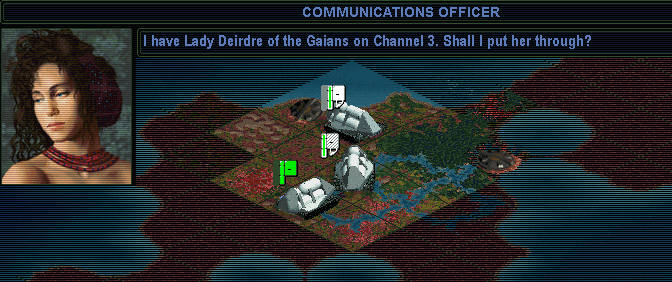
Contacted Gaia right away on the first turn! Wish I'd known that was coming, so I could have picked a different starting tech and traded it for her Centauri Ecology. (It's impossible to reload to do that - the first autosave happens after you pick that starting tech.) But an enormous amount of consequences still followed.

First, I did sell her my other starting tech of Information Networks for 25 credits. (This is a bug, an AI will always be able and willing to pay 25 credits for a tech even if it doesn't have 25 credits. The AI's money goes negative and then gets corrected back to zero on the next turn's production processing. I continued to do this with every single tech I researched throughout this entire game.)
Then I checked the commlink window, which showed that the planetary governor proposal was available, meaning Gaia was the only other faction who had spawned. (This often happens on these micro maps, that many AIs never exist at all. I think factions aren't allowed to land in the monsoon jungle, but even so, there should be some space available for someone somewhere. But for whatever reason, we only got Gaia this time.)
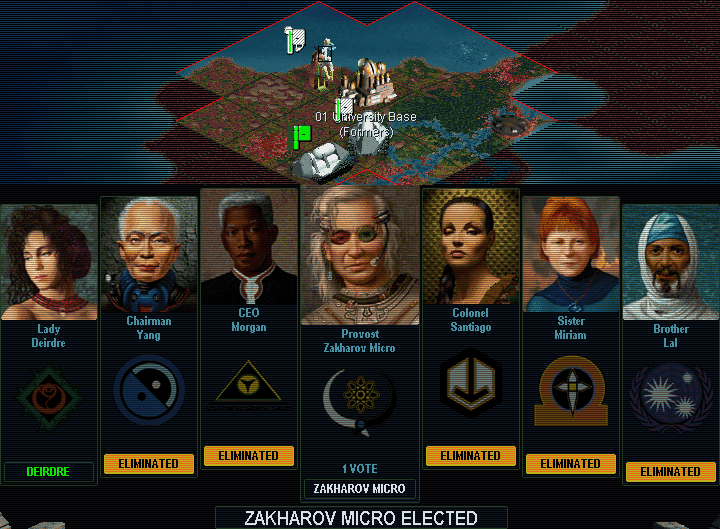
So instead of moving my other colony pod onto the river and jungle as I wanted, I had to settle University Base right now on the starting tile — both to prevent Gaia from settling before me, and to have the 1 vote to win the planetary governor election! (I tested by reloading: if I didn't call the governor vote, Gaia would, which would deadlock 0 to 0, meaning 20 years locked out of governorship until we could vote again.)
Finally, my scout popped the supply pod, which yielded a monolith, very nice to have a good tile for the base to start working. And I used Gaia's cash to rush that first terraformer.
That all happened on the very first turn. On turn 2, we researched our first tech of Industrial Base, and sold it to Gaia for another 25 nonexistent credits. That money would rush a former in my second base.
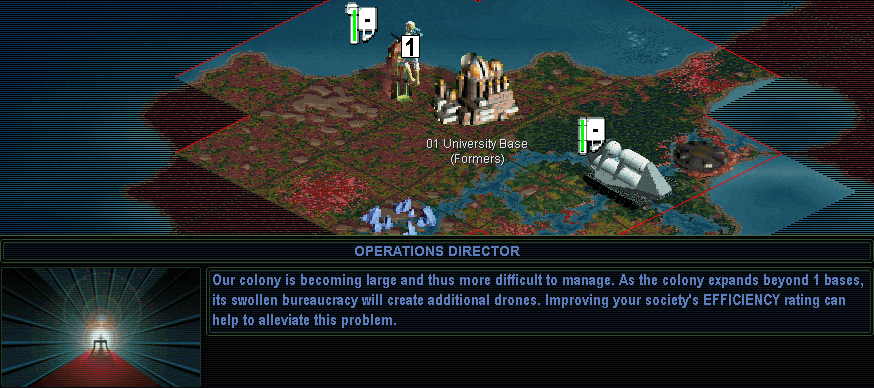
And now the problem to deal with is drone anger. As mentioned in the old report, on the 16×16 micro map, the bureaucracy limit is ONE BASE. With just two bases, each has a bureaucracy drone already. The only usable option was the psych slider. But that was solidly workable just fine: each base was already producing 5 energy, between the river and monolith and governorship, so it took only 40% psych for each base to handle its one citizen.

In fact, I even had enough energy to research two techs next turn! With this game setup, early techs cost only 4 labs each, between the inherently low cost on the micro map and the discount given to research factions. Each of my two bases could research an entire tech by itself this turn, with the 3.6 labs from the second base getting rounded up to 4. So then on turn 3, I researched both Industrial Economics and Planetary Networks, and again sold them to Gaia for 25 more phantom credits each.
That money from Gaia went into adopting Free Market for me also here on turn 3. Meanwhile, now the former from base 02 popped the other supply pod, which also yielded a monolith, particularly nice since that replaced fungus on that tile. Between Free Market and the new monolith, now we could drop from 40% to 30% psych slider and still have the necessary 2 psych at each base.
Turn 4: research Industrial Automation. Although, sadly, now Gaia declined communications so she couldn't pay me for it. I came up just short of enough credits to adopt Wealth this turn, and had to lower the labs slider for enough economy to get it next turn. Then next turn Gaia did speak anyway to buy Ind Auto, and that money went into rushing the first supply crawler in my HQ.

So here we are on turn 5, with the techs up to Industrial Automation completed, and already in social engineering of Free Market + Wealth thanks to all Gaia's phantom cash. Now the important thing going on is that rocky-mineral tile. Such a tile with a mine and road goes all the way to a monstrous 7 mineral production even before cap lifting. University Base presently completed its first supply crawler, which of course would be destined to convoy that tile... but in the meantime, first it actually crawled food for two turns, for base 01 to grow and put out a colony pod sooner, while base 02 worked the mineral mine to complete its own crawler sooner as well. (University Base ended up poorly timed to work or crawl the minerals right away; the minerals would have completed a colony pod too soon before growing, but trying to fit in any other build item [former/crawler] would have delayed the colony pod at least one extra turn after growing.)

Presently my scout was moving through that fungus bottleneck into the jungle, to start picking up more supply pods. This one turned up an alien artifact, nice, and the next one adjacent yielded an energy bonus. More pods later in the jungle gave a monolith, another energy bonus or two, and a somewhat belated Unity Rover but it would become useful to fight worms.
Back home, each base was growing to size 2 for one turn (requiring psych up to 40%) to put out a colony pod. And after that mineral mine, the formers started on forests.
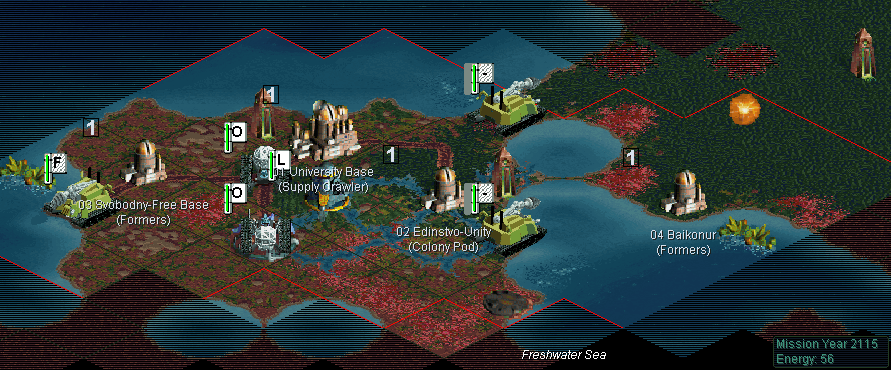
Here we are on turn 15, with those two more bases, including eastwards where that colony pod had to push through that fungus bottleneck to get there. I kept carefully micromanaging everything around that rocky mineral tile, switching it among bases every turn, using it to complete a former or crawler or colony pod for whichever base could at any moment. (It's even possible to work a single tile multiple times on one turn: if a base completes a build item, you can zoom to that base to take it off that tile and use F4 to jump to another base that can click on and also work that same tile that same turn! That feels a little too close to both outright cheating and micromanagement hell so I didn't do it, but an even more dedicated speedrunner could.)
Happiness was handled with the psych slider. As my old report also described, the bureaucracy drone mechanic is capped so that the first citizen in a base is never a superdrone, only a regular drone. 30% psych slider during this time was enough to handle that single citizen in every base.
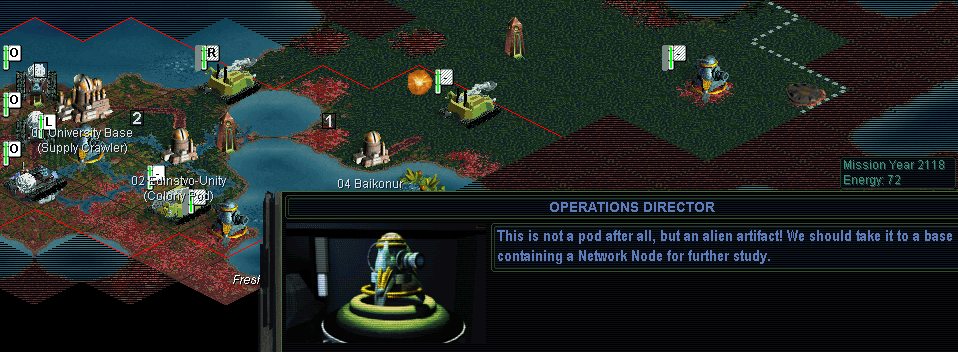
Next big news: turned up two more artifacts from two more supply pods! But although the game tells you to spend them at a network node for a free tech, I wouldn't do so. The tech you get is random (unless you reload to force luck abuse, which isn't what I'm trying to do here), and any tech off my planned beelines would actually hurt, by raising the cost for the techs I do need. And the raw labs value of any tech on the micro map is at its lowest, of course. Rather, I would use all three artifacts for their alternate use, of 50 minerals towards a secret project, which actually seemed to be the stronger push up the snowball curve.

One other bit of news was what was happening with my rival Gaia. From where we both started, once I settled my base, her colony pod began to walk far away westwards along the south polar rocks. I was starting to worry that she would never settle at all and her pod would get eaten by worms, which would declare me the victor and cut off the game, but presently she finally did settle her base at the opposite end of the jungle 20 turns later. (I took this screenshot after finishing the game by reloading into the scenario editor for a god overview.)
Now comes the major improvement I wanted to make in the first half of this game compared to my old speed run. This is the Planetary Transit System, combined with a beeline to Advanced Military Algorithms.

After Industrial Automation, my research beeline was directly to Adv Military Algorithms, a total of six more techs. This gives two very important capabilities: repeal the U.N. charter to enable nerve stapling, and Power SE for a temporary fake switch into the industry penalty to inflate the mineral value of supply crawlers towards secret projects. And it's on the beeline to the Cloning Vats. I reached A.M.A. here in year 2119, far sooner than the old speed run in 2144.
I was also able to complete the Planetary Transit System this same turn. Compared to the mid 2130's in each other game here, this time I was set up to do it as soon as year 2120! I had assembled enough minerals thanks to reaching Industrial Automation so fast to start building crawlers early, the rocky mineral tile to build them quickly, one alien artifact for 50 minerals, a fake SE switch to Power to inflate crawler value, and then a real SE switch into Planned's industry discount. With all that, the project would take only 5 supply crawlers, where 9 is usual without any of that.
Although I ended up delaying the PTS by one turn, because of this:

The 40 credits needed to switch to Planned instead ended up paid to Gaia for her vote to repeal the charter. I decided it was more important to nail this down right away, before she changed her mind or raised the price or refused comms; I didn't have the luxury of subjugating and controlling her as I did in the old run. (Full disclosure, I tried the charter repeal first to see if she'd vote yes on her own, then reloaded to buy her vote. I expected she wouldn't, since her base wouldn't yet be big enough to have any drone problems.) But anyway, this turned out to delay the PTS by just one turn of high economy slider to reaccumulate just enough money to then adopt Planned.
Why Planned? The purpose wasn't the industry discount (although it helped); it was to get out of Free Market to enable nerve stapling. Here was my grand plan: at the start of year 2121, on the same turn I built the PTS, I nerve-stapled every drone on the planet. By using F4 to scroll ahead from the HQ during production processing to each other base in line, just after it jumped to size 3 but before it processed its check for a drone riot.
I can't communicate well enough how perfectly this came together. Every other game with the PTS has had some transition period running a big chunk of psych slider to handle the drones, until I could build something else for it, Virtual World or Human Genome or Longevity Vaccine or police units or rec commons. But this time, nerve stapling meant everything was already at full productivity instantly, exactly as I wanted. Only on the micro map is it possible to reach Adv Military Algorithms fast enough to have in time for the PTS; on normal maps it takes until the 2150's or so. (I'm really not sure what happens if you just staple in violation of the charter and let it be an atrocity; maybe that's actually feasible too.)
Well, okay, it wasn't quite full power yet. Because I wasn't in Free Market, but would be stuck in Planned economics for a little while, where I had to stay to continue to staple new bases as they were founded. At least the industry helped with the colony pods and formers and crawlers, and even the growth bonus which is usually moot with the PTS also did help in growing a few cities that happened to accumulate enough jungle food. But Free Market is where the real juice is, the energy buys more minerals than an industry discount saves. And to get back to Free Market I still had to do the Virtual World for drone control as soon as I could assemble enough crawlers. As we know, the Virtual World for two drones plus the PTS's own effect for one is perfect drone control for every size-3 University base. The VW came in year 2128, by using my other two alien artifacts for minerals plus four supply crawlers, inflated by a temporary flip to Power SE again as usual.
So then in 2129 I could adopt Free Market for real, now running a fully powered and drone-controlled economy ten turns sooner than any other attempt or method. This was much better drone control than the old run, which wasted tech up to Intellectual Integrity, minerals on police units, and opportunity cost in running Planned to allow those police units instead of Free Market. So now I was already at almost one tech per turn on the micro map, fifteen turns sooner than the old game which didn't manage that until after population booming. Also I got the tech freebie from Secrets of the Human Brain; in many other games I lose that to a rival while going towards Ind Auto. And I added the Weather Paradigm with the next batch of crawlers, in 2133.
From there I expanded as usual, rushing colony pods and formers. No particular need this time to rush each colony pod on each base's first turn of existence, so I often waited a turn or two to save money and build roads. And this time I didn't use rover formers; by the time any got built, I would've already filled up the entire micro map. So here we are as I complete my expansion in year 2136:
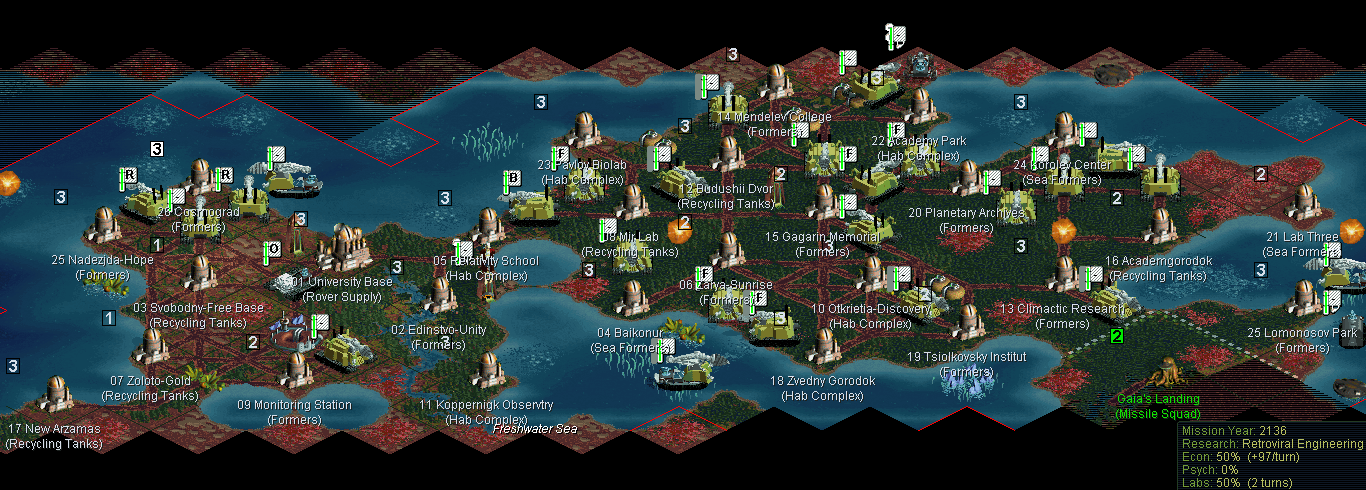
I expanded to a total of 27 bases covering the entire world's landmass, more and denser than in the old run. It's possible to raise more land to keep going, and I did in one spot west of my HQ, but I felt it was already too late for any more. It takes several turns to raise the land and walk formers and colony pods onto it... and then ultimately the limiting factor is that those bases get founded too late for this reason: when booming starts, I want to spend just one turn out of Free Market to nerve-staple everything at once, so any base founded after that misses the stapling and can't grow for lack of drone control. So I stopped at this amount of land and bases.
Rather, I made use of the ocean space by way of quite a few sea formers planting kelp. As I observed before, the metric of productivity-per-former-turn seems to be the key, more than per tile or per population. Kelp farming at 3 turns for +2 food is better by that metric than any option for land-based formers, particularly considering that moving into position doesn't spend a turn, and the kelp expands by itself too. I made particular use of kelp in the large Freshwater Sea at the south of the map. (Which meant I had to be really careful with eco-damage: any sea level rise would flood the single 10m-elevation tile protecting the fresh water from the ocean!)
The land terraforming came out somewhat more haphazard than I anticipated. I had intended to terraform mostly with farms, to get the population way up... but found myself continuing with forests in the jungle for quite a bit longer than I'd intended. I planted forest on every flat tile, which really felt necessary for all those bases to build their two formers and get up off the ground, then finally got going with some farms on rolling tiles.
I decided not to build a crapton of terraformers as in the old speed run. Rather, I had each base build the two that can be freely supported, but then stopped before incurring support costs. Clean formers were an option, but they didn't quite feel worthwhile; without an industry discount to build them, and with a very short time horizon to transcendence, it felt like they wouldn't quite pay back the investment. So overall, I managed the terraforming quick and dirty and lean ("perfect is the enemy of good"), just slap down whatever forest or farm could be done expediently for some value and then move on. I would not build a grid of maximum possible boreholes everywhere like in the old speed run, just some on rocky tiles as the best use of them rather than laboriously fixing them for food.
That screenshot also shows a mix of build orders. A few bases mostly outside the jungle did recycling tanks first. But the major story there is the hab complexes. I always warn new players against those: capping out at size 7 does not mean build a hab complex now, that's 80 minerals spent on no productivity increase at all, it means improve your base by other means instead. But I strongly felt that hab complexes really were the way to go this time. With the vast jungle, lots of kelp, and satellites coming soon too, we should have quite a bit of food headroom to reach the doubled cap in most every base. Finally, my tech path wouldn't go to the Ascetic Virtues for that population cap raise for quite some time, so the hab complexes were starting from up over a lower baseline.
But merely being able to reach the size cap doesn't define the value of the hab complex. The value of any build order exists not in isolation, but compared to other possible options. I didn't want more support-costing formers, with most tiles already improved workably if imperfectly. Tree farms are what I often build at this time, but that wasn't my plan here with less forest and lots of jungle and kelp, and also the enabling tech wouldn't come until later. Science multipliers would seem to be the next priority... but when you think about it, they're really not all that good. The University gets the network nodes for free, of course. Research hospitals are next, but really not great; nerve stapling means the psych and drone components are useless, so it's just 120 minerals for +50% science, an overcosted network node. Fusion labs give +50% economy along with the science, which is considerably more worthwhile, but they don't come available until after a fairly lengthy chain of midgame tech prerequisites. So really, hab complexes were the item to build, just because they could start earlier than fusion labs and there wasn't anything better.
More generally, the more speed-runs I play, the more I realize that building things with minerals isn't all that great. Anything fairly costed in terms of minerals isn't good enough compared to the drastically undercosted areas of population booming and nerve stapling and satellites and specialists. (Specialists are secretly undercosted, in being a productive job without requiring terraforming investment.) Building for mineral production really doesn't improve a speed run. Bases tend to rack up enough incidental minerals for about one medium sized build item each, and a hab complex actually seems to be the best way to do that, because that unlocks more headroom to keep going with the undercosted areas.
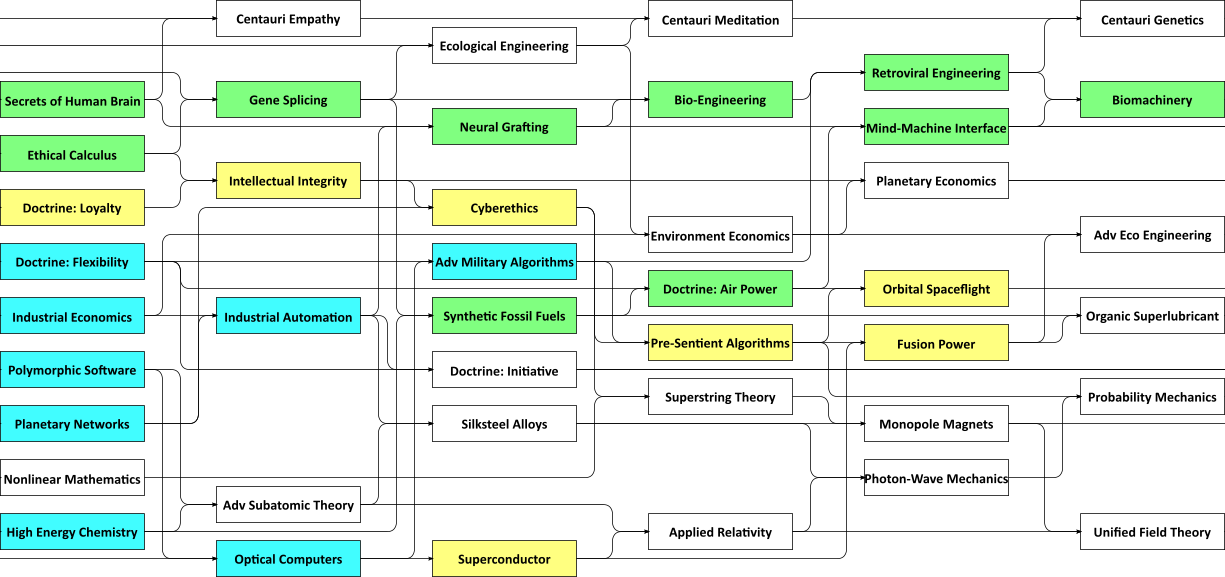
Presently came the other major improvement compared to the old speed run: beelining directly to the Cloning Vats for population booming. As I described in the other reports, booming by way of SE settings has significant downsides: the support cost of Democratic, the opportunity cost of Planned in not running Free Market, and the mineral cost of the children's creches. A faction with good research power (obviously University, but also Morgan and really anyone who can usefully run Free Market) can simply research to Biomachinery fast enough to cut past all those other concerns.
I reached Biomachinery at the start of year 2139. As usual, I switched to Planned economics for that one turn, to apply nerve stapling everywhere. (But not as usual, I didn't get to take advantage of that one turn of Planned industry discount for rushing any builds, since it took all my money to upgrade supply crawlers for the Vats.) Then at the start of 2140, my HQ completed the Cloning Vats and everything started booming. Somewhat surprisingly, this was only four turns faster to start booming compared to the old run doing it with creches instead. But the real difference would be this run staying in Free Market for good, rather than needing several turns in Planned to execute the boom.
Reading back through the old report, I'm actually cringing at the tech path. Booming via creches instead of Vats might be a defensible approach... but then that game's next beeline target was Adv Ecological Engineering. That's definitely not great. The super formers built from that had a lifetime of all of about 15 turns before the game ended. Remember that formers decline in value quadratically: they represent as much as three degrees away from real productivity: first you build the former, then it builds a forest, then those minerals build a multiplier facility, and only then do you really gain anything towards science.
Rather, the better midgame beeline target is Orbital Spaceflight, particularly also after sharing half of its prerequisite path with Biomachinery and then the other half with Fusion Power. Orbital food is only one degree away from productivity and that happens immediately by booming. Satellites aren't quite as miraculously overproductive with 27 bases as with 80 or 180, but they're still bigger payback than any other available build item. Running the numbers: 960 energy spent on 480 minerals for 4 food satellites to (halved without aerospace complex) add 2 food everywhere, results in 27 fusion engineer specialists, which each pay back 6 per turn (3 energy + 2 labs + 1 from the network node multiplier) for a total of 162/turn, which all comes to payback in 6 turns against the cost of the satellites.
And there's another concern regarding evaluating these tight payback windows. The real target isn't necessarily the end of the game. It's the intermediate breakpoints, particularly Cybernetic SE and Transcend specialists. If a line of play pays back before the end of the game but not before those breakpoints and delays them, it's possible for that to be a net loss against reaching those breakpoints sooner. I learned that from the Civ 5 games, speed to the end wasn't determined by total productivity, but by speed to those intermediate steps of enabling the next science increases. Here, that meant not going for Advanced Spaceflight after Orbital. An energy satellite powering 27 bases would pay back in roughly 12 turns or so - but that's not good enough since the tech is offline from and delays Digital Sentience and Secrets of Alpha Centauri.
One thing missing from that chart: in most games I pick up a number of side techs by trade and theft, but not here with just one crippled rival. In fact, right after Biomachinery I got stuck for a moment with no available progress towards Spaceflight or Fusion, when every possible prerequisite to those lines (only Doctrine Loyalty and Superconductor) fell into a missing-tech hole, techs I've usually picked up from someone else by now. So for one step I had to divert somewhere else, which would be Ecological Engineering, which I needed sometime anyway for uncapped borehole yield. (Gaia was in fact researching Ecological Engineering, as she almost always does, but her single feeble base would take 90 turns for it.) Later, after Fusion Power, I had one more unavoidable hole on the run up to Digital Sentience, so I rearranged my tech order through that stretch to start with Environmental Economics to fully uncap the boreholes.

As always, I carefully micromanaged every base every turn during the population boom. (It was actually amazingly refreshing to do this for 27 bases in five minutes per turn, instead of hundreds of bases in an hour, heh.) Here's one interesting detail. Sometimes there wouldn't be enough food available in an area for every base to boom, no matter how I arranged it. So then the best solution was as shown in this picture: make sure one base takes all the hit of giving up food tiles to skip booming for one turn, burning down its storage, so every neighboring base can pick up the food tiles instead and make sure to boom. The important detail was to do this with bases that had reached size 5, since that's required to enable the better types of specialists. In fact, my overall labs pace jumped by about 50% right when the boom reached size 5 thanks to enabling librarian/thinker specialists.
Next it was time for another usual midgame tactic. In year 2148, the nerve stapling that had begun just before the Cloning Vats expired after ten turns, so I had to get out of Free Market once again for one turn to staple one more time. So I saved up money for a few turns before that, then spent it all on that one turn of Planned's industry discount. That rushed about 20 hab complexes, to keep the boom going for a long run thereafter.
Also as usual, I started building food satellites as soon as I got Orbital Spaceflight. A detail that has happened in other games here but I haven't mentioned it: the HQ base is actually a poor choice for a hab complex, because of its role in building satellites instead. The HQ is the most important base to build satellites, because then every other base downstream benefits that same turn. But the HQ itself is the last to gain orbital food from itself and bases after it in production order, not until the following turn, making it less able to boom and fully use a hab complex. So as has happened several times before, the HQ and some other bases early in the production order kept building satellites every turn and never got around to the hab complex. (A detail of rushing the satellites: make sure the base is producing at least 10 minerals, and always buy enough so that the base overflows by 10, to put it in position to rush another satellite consecutively on the next turn too.)
Here's an overview in year 2150 to compare to the old speed run. Most bases are at size 9 because they had been at size 7 until two turns ago, when they rushed their hab complex on that single turn of Planned industry, then resumed and continued to population-boom every turn.
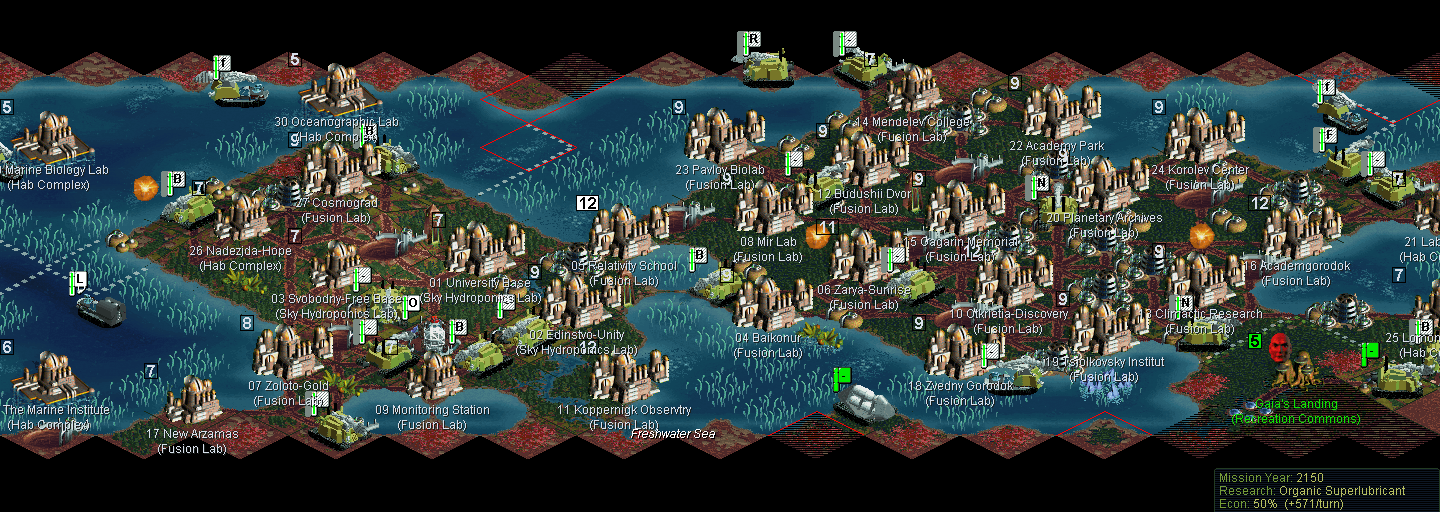
For the giant difference between the two, look at the terrain and the build orders. The old game was still building formers on turn fifty! And had maybe half the land terraformed. That's why not to sink a thousand minerals into children's creches: build formers instead. This game built all of them twenty turns ago and has already terraformed everything now. And that better terraforming snowballed into more minerals, enough to already have built the hab complexes and food satellites.
Another fun feature shown here: Sea bases! I never used them in any other report here, but now there was a situation that came together just right. Sea bases are generally bad because sea colony pods are tremendously expensive, at 70 minerals. That's because the cost includes a pressure dome that counts and functions as a recycling tank, but it's still not really good value. But there's one particular breakpoint that makes sea pods much more feasible: the fusion reactor, which cuts the cost from 70 minerals down to 40. I also took advantage of one particular game behavior: when you do an upgrade from the unit workshop, that also switches all builds-in-progress to the new version with no retooling penalty; so I started prebuilding the overexpensive regular sea colony pods ahead of time, to convert directly into the cheap fusion version when the tech came.
These sea bases also handled the constraints against founding new bases in general in a speed run. New bases take too long to move formers into position and get terraforming done (ten turns from here is almost to the end of the game), but I had the mobile sea formers that had already planted lots of extra kelp. And new bases miss out on nerve stapling so can't handle drones to boom... but I had that lined up perfectly here, founding these sea bases right before the one turn when I already had to switch SE for the next round of stapling anyway. Three sea bases wouldn't work any sort of miracles in the overall picture, but they were fun and positive value for a cheap investment.
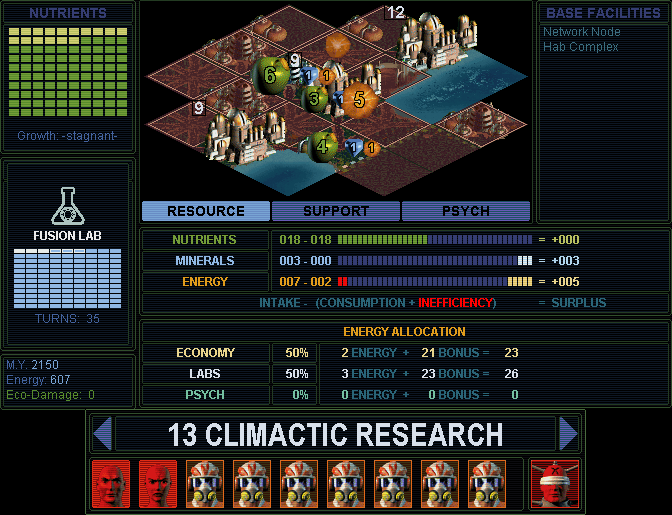
Back to the land bases, let's talk about what they were building next... which was, basically, nothing. Many bases looked like this after the hab complex. Enough food to keep booming (this base will get 2 more from new satellites this turn), but working almost no minerals. And this was fine. Minerals are of no value until the box fills and the build item actually completes... a time horizon that would now be past the end of the game. The right way to play this was to concentrate the mineral production, pick a few bases to grab all the boreholes and forests in range, which would accumulate enough minerals to actually finish a fusion lab, which would in turn multiply the boreholes' energy. But for bases like shown here, I really didn't care if it never built anything else at all; no build item would give better return on money than more food satellites.
That lack of minerals is a very minimizable downside. That confluenced with presently shifting my SE into the endgame configuration:
- 2148: adopt Planned for one turn for the next round of nerve stapling
- 2149: back to Free Market
- 2150: Democratic (from Frontier)
- 2151: Knowledge (from Wealth) and 100% labs slider
- 2153: Cybernetic
This was the right way to go. Now the support penalty of Democratic was an acceptable downside; mineral support is meaningless if the minerals will never complete anything anyway. The growth was moot, but the Efficiency was key, not to reduce energy losses (which were minimal on a micro map; the formula doesn't scale down with map size unlike Civs 3 and 4), but to reduce the penalty for unbalanced sliders so I could go 100% labs. Finally, Knowledge came last in that sequence to hold on to Wealth briefly for two more turns of industry discount on rushing satellites. But then after that Wealth's industry didn't matter either while hardly building anything. The Civ 5 speed runs taught me how to do this, don't get caught up on making every base perfectionalistically perfect, eyes on the prize, just get it up to size with the specialists that account for the bulk of the labs.
My mineral production also fell doing another thing that needed to be done now: whack forests into farms instead. Switching a rainy tile from forest to farm is +2 food, and one engineer specialist is more usefully productive than one forest, because the engineer's output is energy that can be spent anywhere on whatever item gives the fastest payback (which was still yet more food satellites), while the forest minerals would accumulate in the box doing nothing. Although then a bit later with Adv Eco Engineering tech, then a soil enricher plus condensor (9 food in the jungle!) did become better food yield (on top of a jungle farm at 4 food, that adds +5 for 14 former-turns) than farming over forests.
And of course, the low mineral production meant no worries about eco-damage. I did get a few fungus pops from bases working multiple boreholes, but only a few small worm spawns, and none that threatened a sea level rise.
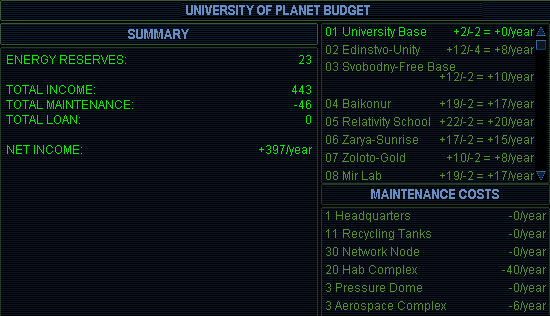
My major constraint was money. I was making about 400/turn, then 600 after Cybernetic SE (paradigm efficiency to eliminate the penalty for unbalanced sliders), but then back to 400 once the engineer specialists became transcends instead. That's a far cry from the 2000 or more income on bigger maps with more bases. This money all went into food satellites for a very long time, barely affording two per turn for a stretch of ten turns. Six satellites per turn is common on bigger maps; here just two per turn could barely scratch out enough to keep up with the still-proceeding population boom. And another problem became upgrading supply crawlers for projects (Nanofactory, Ascetic Virtues, Supercollider), and I would never get around at all to several (Xenoempathy Dome, Network Backbone, Living Refinery.)
But here's one answer to help build what I need (and I reloaded one turn back to do this correctly once I realized it): after Cybernetic SE arrived, I could switch back to Wealth!
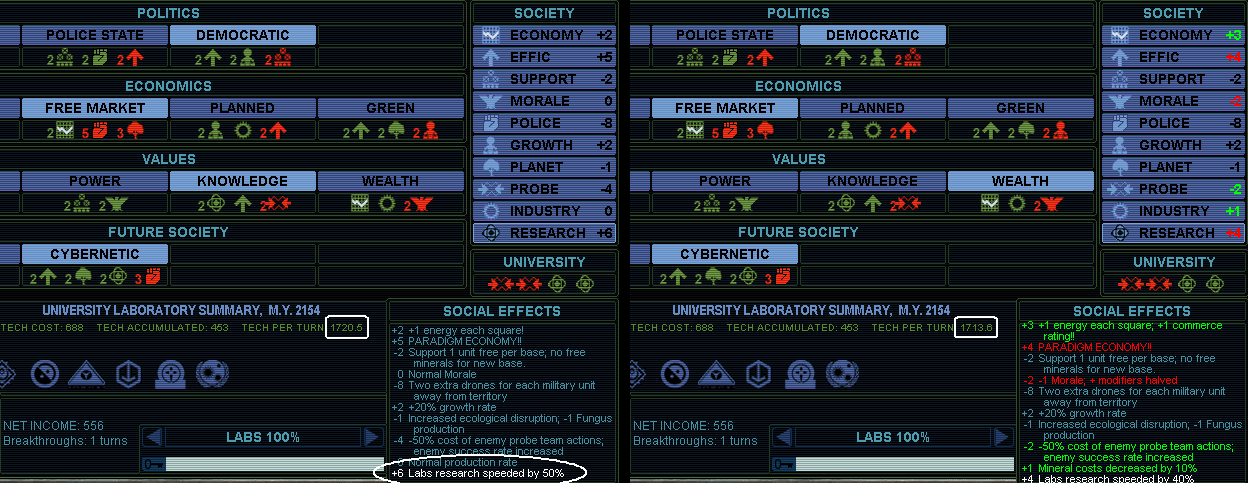
This shocked the hell out of me, both the mechanic and that I had never realized it before. The Research SE setting maxes at +50%. The University with Cybernetic and Knowledge has +6 Research rating, but that only gives +50% as the datalinks accurately says, not +60%. This meant that Knowledge was only really adding +10% research, not 20%, on top of the other two locked-in factors. And it's not really 10% either, it's additive on top of the other factors, so it's really just 10/140 = 7.1% of the final value.
And shockingly, Wealth's economy nearly identically matched that! It's only +2 energy per base, which should seem small against all the boreholes and specialists... but that piped through the SE and network node multipliers actually did come to a virtually identical total of labs. So given that, then of course Wealth's industry discount is superior, and made a significant difference in rushing satellites and secret projects. (Particularly because of how the crawler math works out: the most expensive crawler upgrade target available for a long time is 0-3-2 Drop Trance at 270 minerals, which is exactly enough to complete a 300-mineral project with a 10% industry discount. Without the discount, you need to scramble for that last 30 minerals somehow, but it's a pain to somehow fit in another crawler or overpay for rushing.)
In year 2155, after Cybernetic SE and on the way to transcend specialists, I finally did get Planetary Economics tech to do the Ascetic Virtues secret project. So two turns after that, many bases reached the full size 16 cap. So now I could sell the hab complexes in those bases for extra money. And I could stop building food satellites. A few bases still needed to boom a little more, which they would do by taking food tiles away from bases at max size, since those bases could simply work a food deficit and burn down accumulated storage until the end.
Now I could finally get around to energy satellites, and out of habit rushed three on the first turn I had Advanced Spaceflight tech. But then I ran the numbers and realized that an energy satellite powering 30 bases really wasn't efficient enough. I could get better value by rushing some of all those halfway-finished fusion labs to completion, to finally convert those idle minerals to something useful. This all was happening late enough that there would be no real payback horizon for the money before the end, but rather was the best outlet for converting the money from transcend specialists into labs somehow.
Finally, the last major difference between this and the old speed run was in ignoring and postponing the labs-doubler projects. The old report made a big deal of those super-science-center cities... but doubling the output of two bases out of 30 just isn't all that important. Even considering it's really more than double since those cities get priority on boreholes and regular science multipliers, that's still not enough to justify the cost of researching the enabling techs. Applied Relativity and Unified Field Theory just aren't on the beelines to anything important, so why worry about doubling two cities, compared to doubling the entire faction's productivity at breakpoints like satellites, fusion engineers, Cybernetic, and transcends. There was no step at which diverting to Applied Relativity would pay back that tech's cost before the next major faction-wide breakpoint. So the labs-doubler projects both ended up coming three turns from the end as the last gain on labs after everything else.
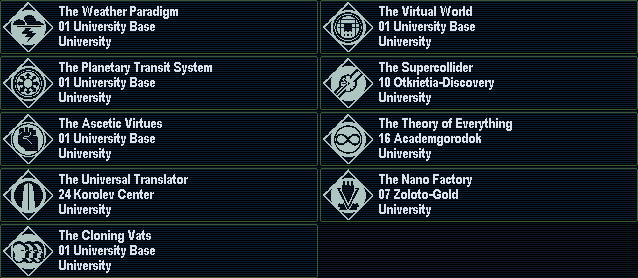
Since the old run showed it, here again is the list of all secret projects I built.
And this time my tabular report will show the progress of the entire game, to follow the growth and productivity in detail:
| Turn | Techs | Bases | Population | Effects | Economy | Labs |
| 2101 | Information Networks, Centauri Ecology | 1 | 1 | 3 | 3.6 | |
| 2102 | Industrial Base | 2 | 2 | 50% psych slider, 40% labs | 0 | 9.6 |
| 2103 | Industrial Economics, Planetary Networks | 2 | 2 | Free Market, 30% psych, 50% labs | 2 | 12 |
| 2104 | Industrial Automation | 2 | 2 | 50% economy, 20% labs | 6 | 4.8 |
| 2105 | 2 | 2 | Wealth, 20% psych, 30% labs | 8 | 7.2 | |
| 2106 | 2 | 2 | 40% economy, 40% labs | 6 | 12 | |
| 2107 | Polymorphic Software | 2 | 2 | 6 | 12 | |
| 2108 | 2 | 2 | 6 | 12 | ||
| 2109 | Applied Physics | 2 | 2 | 40% psych, 20% labs | 6 | 7.2 |
| 2110 | 2 | 3 | 30% economy, 30% labs | 5 | 12 | |
| 2111 | 2 | 2 | 50% economy, 20% psych | 9 | 8.4 | |
| 2112 | Doctrine Mobility | 3 | 3 | 30% psych, 40% economy | 9 | 15.6 |
| 2113 | 3 | 3 | 30% economy, 40% labs | 6 | 20.4 | |
| 2114 | 3 | 3 | 6 | 20.4 | ||
| 2115 | Doctrine Flexibility | 4 | 4 | 8 | 24 | |
| 2116 | 4 | 4 | 10% economy, 60% labs | 4 | 27.6 | |
| 2117 | Optical Computers | 4 | 4 | 4 | 24 | |
| 2118 | 4 | 5 | 30% economy, 40% labs | 9 | 24 | |
| 2119 | Adv Military Algorithms | 5 | 5 | 70% economy, 0% labs | 19 | 0 |
| 2120 | 5 | 6 | Planned, 0% psych, 50% economy & labs | 12 | 28 | |
| 2121 | 7 | 19 | Planetary Transit System, nerve staple | 17 | 42 | |
| 2122 | 7 | 17 | 18 | 42 | ||
| 2123 | Social Psych | 8 | 18 | 19 | 42 | |
| 2124 | 10 | 24 | 22 | 54 | ||
| 2125 | Biogenetics | 12 | 29 | 24 | 60 | |
| 2126 | 13 | 32 | 24 | 62 | ||
| 2127 | Ethical Calculus | 13 | 32 | 25 | 58 | |
| 2128 | 14 | 35 | 27 | 66 | ||
| 2129 | Gene Splicing | 16 | 38 | Virtual World, Free Market | 61 | 130 |
| 2130 | Secrets of Human Brain, Neural Grafting (free) | 17 | 40 | 64 | 140 | |
| 2131 | High Energy Chemistry | 20 | 48 | 73 | 158 | |
| 2132 | 21 | 51 | 76 | 168 | ||
| 2133 | Bio-Engineering | 23 | 54 | 82 | 181 | |
| 2134 | Synthetic Fossil Fuels | 24 | 60 | 85 | 188 | |
| 2135 | Doctrine Air Power | 24 | 60 | 84 | 188 | |
| 2136 | Mind/Machine Interface | 27 | 69 | 97 | 210 | |
| 2137 | Retroviral Engineering | 27 | 71 | 100 | 208 | |
| 2138 | 27 | 72 | Planned | 41 | 103 | |
| 2139 | Biomachinery | 27 | 75 | Free Market | 101 | 218 |
| 2140 | 27 | 99 | Cloning Vats to start population boom | 111 | 241 | |
| 2141 | Ecological Engineering | 27 | 124 | Size 5 for librarian/thinker specialists | 113 | 388 |
| 2142 | Doctrine Loyalty | 27 | 146 | 118 | 496 | |
| 2143 | Intellectual Integrity | 27 | 164 | 119 | 598 | |
| 2144 | Cyberethics, Superconductor | 27 | 171 | Bases start to reach max size 7 | 122 | 614 |
| 2145 | Pre-Sentient Algorithms, Orbital Spaceflight | 27 | 178 | Technicians (will convert to engineers) | 256 | 393 |
| 2146 | Fusion Power | 27 | 187 | Engineer specialists, food satellites | 366 | 556 |
| 2147 | Adv Subatomic Theory | 28 | 198 | Some hab complexes | 409 | 619 |
| 2148 | Environmental Economics, Nonlinear Mathematics | 30 | 211 | Planned, new sea bases | 338 | 504 |
| 2149 | 30 | 233 | Free Market, many rushed hab complexes | 479 | 751 | |
| 2150 | Superstring Theory, Silksteel Alloys | 30 | 256 | Democratic | 571 | 879 |
| 2151 | Organic Superlubricant | 30 | 278 | Knowledge, 100% labs | 349 | 1243 |
| 2152 | Monopole Magnets, Nanominiaturization | 30 | 300 | 397 | 1352 | |
| 2153 | Industrial Nanorobotics, Digital Sentience Adv Eco Engineering | 30 | 316 | Cybernetic | 539 | 1699 |
| 2154 | Planetary Economics, Centauri Empathy | 30 | 331 | Wealth | 563 | 1776 |
| 2155 | Centauri Meditation, Centauri Genetics Centauri Psi | 30 | 360 | Ascetic Virtues Thinkers (will convert to transcends) | 399 | 2132 |
| 2156 | Sentient Econometrics, Secrets of Alpha Centauri Applied Relativity (free), Advanced Spaceflight | 30 | 390 | Transcend specialists | 522 | 3322 |
| 2157 | Unified Field Theory, Photon/Wave Mechanics Probability Mechanics, Doctrine Initiative | 30 | 404 | Labs doubler projects A few energy satellites | 624 | 4224 |
| 2158 | Nanometallurgy, Homo Superior Matter Compression, Super Tensile Solids Will To Power | 30 | 405 | Knowledge, rushed fusion labs | 727 | 4656 |
| 2159 | Self-Aware Machines, Eudaimonia Matter Editation, Secrets of Creation Matter Transmission (free) Singularity Mechanics (free) Temporal Mechanics (free) | 30 | 405 | Assign some transcends back to food tiles | 615 | 4308 |
| 2160 | Threshold of Transcendence | 30 | 405 | Transcendence | ||
As illustrated and as usual for these games, my labs rate came up to over four techs per turn in the end. Interestingly, that came out about the same on the micro map as my best games on a standard size map.

The ending wasn't perfect; on the penultimate turn I came 400 labs short of finishing the last tech and couldn't come up with any way to plug that gap. Every base was already working maximum transcend specialists and an absolute minimum of food tiles to burn down all accumulated storage. I actually had enough total labs production that would have finished it, but fell afoul of overflow problems. Not with the SSC bases, but just with ordinary ones, it kept happening that a base would only need something like 40 labs to finish the current tech but produced 150 with the rest lost to truncation. I could have saved this turn by rushing another ten more fusion labs - but would have lost that turn on completing the Ascent project since that would have been the money I needed for the crawler upgrades.

And a last overview from that penultimate turn. All the scout patrol build orders are so I could zoom to each city to check on the labs progress each time, trying to manage my way around that overflow truncation, but couldn't get it to work out. But anyway, Threshold of Transcendence finished and I did the usual zoom-ahead during production processing, with 600 and 2000 minerals worth of supply crawlers already stocked into bases 26 and 27, to change those projects to Voice of Planet and Ascent to Transcendence.
My last window of nerve stapling happened to run out right on this turn. Solution: just ignore the drones, let them riot on this very last turn, doesn't matter, we'll complete the projects anyway!
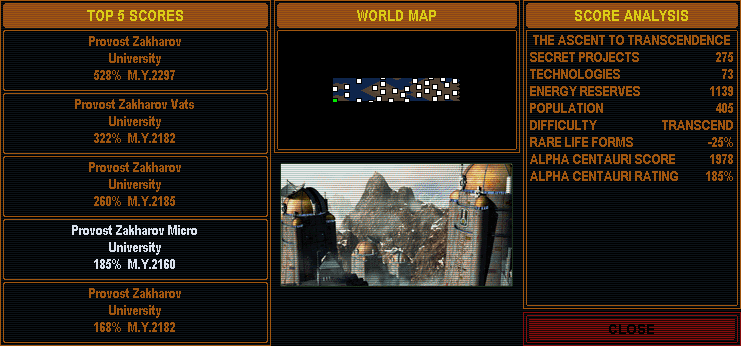
So I completed the transcendence victory in a nice tidy 60 turns! Improved from 76 in that old micro map speed run. Over 20% faster by making all those improvements: the PTS, early nerve stapling to stay in Free Market, more efficient terraforming, the Cloning Vats instead of creches, food satellites, and significantly more population with a denser build and food satellites and hab complexes.
As in the old report, here's a zip file with all the saves from every turn to see for yourself.
I am satisfied, and this most likely represents the true conclusion to my Alpha Centauri writeups here. I don't have anything else in mind with a compulsion to try out. Thanks once again for reading, and comments and discussion can be held at the forum thread on Realms Beyond here.